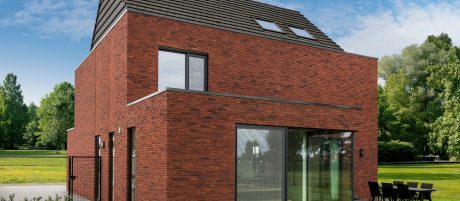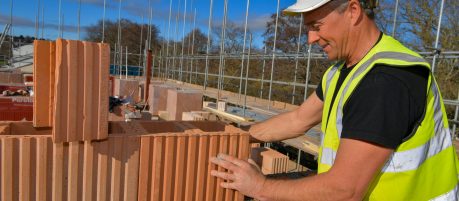

How can architects and manufacturers shape the future of sustainable architecture today?
Gonzalo Bunse, Category Director at Wienerberger UK & Ireland, explores the interconnected roles that architects and manufacturers play in shaping the sustainable buildings of the future.
A balancing act
Embracing sustainable design in the realm of architecture is no longer a choice due to the undeniable reality of climate change and evolving legislation. Architects now face the challenge of surpassing their sustainability goals, requiring departure from the “business as usual” mindset and adopting advancing building techniques.
The objective is clear: discover building solutions that uphold the principles of sustainability and meet the needs of the end users. However, when we add aesthetics, cost, tight schedules, and client expectations into the mix, it can become a complex and delicate balancing act of priorities for the architect.
What is sustainable architecture?
The concept of sustainable architecture is so much broader than simply selecting sustainable construction materials. It’s a philosophy and approach that goes far beyond considering energy efficiency and carbon reduction.
It requires a thorough and holistic approach to an individual project, which aims to minimise the environmental impact of every stage of the process from conception to a building’s end of life phase, whilst maximising the positive economic and social contributions that will extend beyond the construction project boundary.
This holistic approach strives to enhance economic and social contributions alongside environmental benefits, weaving a tapestry of considerations, from prioritizing fabric-first principles to specifying ethically sourced, recyclable and reusable low-embodied carbon materials. The creation of biodiverse green spaces and optimizing user comfort also factor in.
By understanding the life cycle of materials and making responsible design decisions every step of the way, architects and manufacturers can collaborate in creating sustainable spaces that are environmentally responsible, resource-efficient and socially beneficial. The ultimate goal is to design for the present needs of the building’s users, without compromising the building’s ability to adapt and meet the needs of future generations too.
Moving beyond legislation
Amid evolving regulations, architects are tasked with staying abreast of sustainability practices for compliance. An uplift to Part L of the Building Regulations is now in effect, with requirements for improving airtightness, optimizing insulation, and eliminating thermal bridging.
Changes to Part L pave the way for the Future Homes Standard, which is scheduled to take effect from 2025 and will provide stipulations that will ensure new homes produce less carbon emissions during operation, in order to be net-zero ready. We are waiting to find out more about the full details of this standard post-consultation period.
However, it is felt by many that the first iteration of the Future Homes Standard announced in 2021 was not ambitious enough, particularly in its lack of reference to embodied carbon and limits for both operational and embodied carbon. Many are already working beyond this level, for example, due to the high standards set for London residential schemes. RIBA were vocal with their opinion that there was potential to go further to make necessary progress in the field of sustainable architecture, which they hope to influence in future consultations.
“While a 75-80% reduction in carbon emissions is welcome, we’d like to see government implement specific targets for carbon emissions, rather than continuing to compare emissions from existing buildings. Disappointingly – and quite significantly – the government has made no commitment calculating the operational energy or embodied carbon of new homes. We will continue to make the case to government about the importance of these metrics.”1
Biodiversity Net Gain (BNG) regulations, effective from November 2023, entail a land development approach aimed at reducing the ecological damage of construction projects, and at its best can support nature's recovery. Its primary objective is to ensure that the wildlife habitat is improved beyond its original state before development and then maintained for at least 30 years afterwards, which the developer is liable for. For more information on Biodiversity Net Gain, read our blog post.
Legislation around the use of low embodied carbon materials is yet to be realised, but this is a potential future step for regulations to take. In the meantime, projects can be rewarded with credits on BREEAM and LEED schemes for embodied carbon reductions.
The ambiguity surrounding future policy direction and the regulatory requirements beyond 2025 has the potential to create stagnation in the UK built environment sector’s transition to a net-zero carbon emission economy. However, in the context of a climate emergency, there is no time to waste. Architects and manufacturers can take the approach of looking beyond what is required within the law, and proactively set their own targets for the sustainability performance of their projects, products and operations. They will be rewarded with competitive advantage in their markets, until the time policymakers catch up.
Architects: Catalysts of Change
Architects are pivotal in pioneering sustainable architecture, leading by example, and driving design and specification innovation within the architectural community. This influences the industry at large. Their inherent creativity, expertise, and willingness to embrace new solutions position them as trailblazers in the field. Their challenge lies in persuading others to join them on the sustainable architecture journey.
Clients, investors, and stakeholders are increasingly conscious of the environmental impact of their projects, but whilst we are waiting on legislative changes, the mindset change and potential increased investment required to create a sustainable building may be too much to swallow for some, especially where the immediate benefit is not obvious. Architects and their project teams may often find themselves fighting for the case of using sustainable building methods or products, where their design may require more upfront financial investment, but these may yield both ethical and economic rewards in use, such as lower bills thanks to increased energy efficiency and higher occupancy rates over the building’s lifespan.
It is without doubt that early integration of a sustainable mindset on a design scheme is key, as project teams need to be aligned, the project considered holistically with a fabric-first approach, and clear targets outlined from the outset to avoid stumbling over the initial barriers to achieving sustainability goals. This is where architects could benefit from additional support.
Manufacturers: Innovation Leaders
For architects to design with sustainability in mind and gain vital buy in from their project teams and clients, manufacturers such as Wienerberger must step up with high quality product offerings that make sustainable architecture viable. Without the right materials, architects can only go so far down this road.
Manufacturers must invest in innovation by exploring fit-for-purpose alternatives to conventional construction materials and the methods used to produce them. Eventually, certain products within a manufacturer’s portfolio may become obsolete in favour of more modern, more sustainable building materials, so it’s a case of innovate and diversify to survive.
To create sustainable building products, manufacturers must look beyond the product itself and explore its entire lifecycle. This includes meticulous analysis of the raw materials and processes used to manufacture a product (including where renewable or recycled content can be used), as well as its packaging, distribution, installation, use and disposal.
According to the NBS “What Specifiers Want” 2023 report, 14% of respondents said that they almost always specify the most sustainable product on offer, even if other options are much cheaper or perform better. The majority tend to compromise, with almost half (48%) usually specifying sustainably, but not if alternatives are much cheaper or have favourable certification. However, just under a third (31%) need sustainable options to be comparable in terms of cost and performance. This is a clear message to manufacturers that although sustainability is important to most architects, the quality and cost of our eco-friendly building materials needs to rival the alternatives to sway the late adopters.
Alongside improving product offerings to facilitate sustainable design, manufacturers also need to be able to offer support and share technical expertise with architects to help them confidently specify the right materials. This is especially true when working with innovative products that are fresh to the market which may not be used in the same way or have the same proven track record as traditional materials. Data and certification around a product’s sustainability credentials should also be made available to help architects make informed choices.
As projects need to be looked at holistically, products should be assessed as part of a system, rather than in isolation. This is where manufacturers who provide multiple elements of a system can provide value to the architect rather than promoting components on their individual environmental merits, when it’s the performance of the system that matters.
Championing sustainable architecture
Staying ahead in the realm of sustainable architecture requires architects and manufacturers to remain updated on sustainability knowledge, technologies, and best practices to continually improve the sustainability quotient of their projects and products.
Both parties bear the responsibility of becoming championing sustainable architecture, with improvements in communication and collaboration between the two becoming paramount to ensure fit-for-purpose products reach the market. Aligning everyone in the industry is also vital to close the gaps between design intentions and construction outcomes, particularly concerning skills shortages and the challenges of both new build and retrofitting.
It is complex terrain to navigate, and it is undoubtedly easier to stick with the status quo of using the building products and methods we are used to. However, there may be a time in the near future when legislation no longer allows for this, and those who are already succeeding at designing projects and products with sustainability in mind will be a step ahead of the rest.
As we look ahead to the potential impact of the Future Homes Standard, we must remember that the ambition to create sustainable architecture is an ongoing journey, rather than the need attain perfection today. Through shared advocacy, architects and manufacturers can collectively forge a path towards the end goal where principles of sustainability permeate every facet of the built environment.

Contact us
We are committed to developing our suite of sustainable building materials through further innovation and investment, so watch this space!
If you would like to speak to one of the Wienerberger team regarding our portfolio of products that can help you achieve sustainability goals on your next project, please get in touch by completing the form below.




